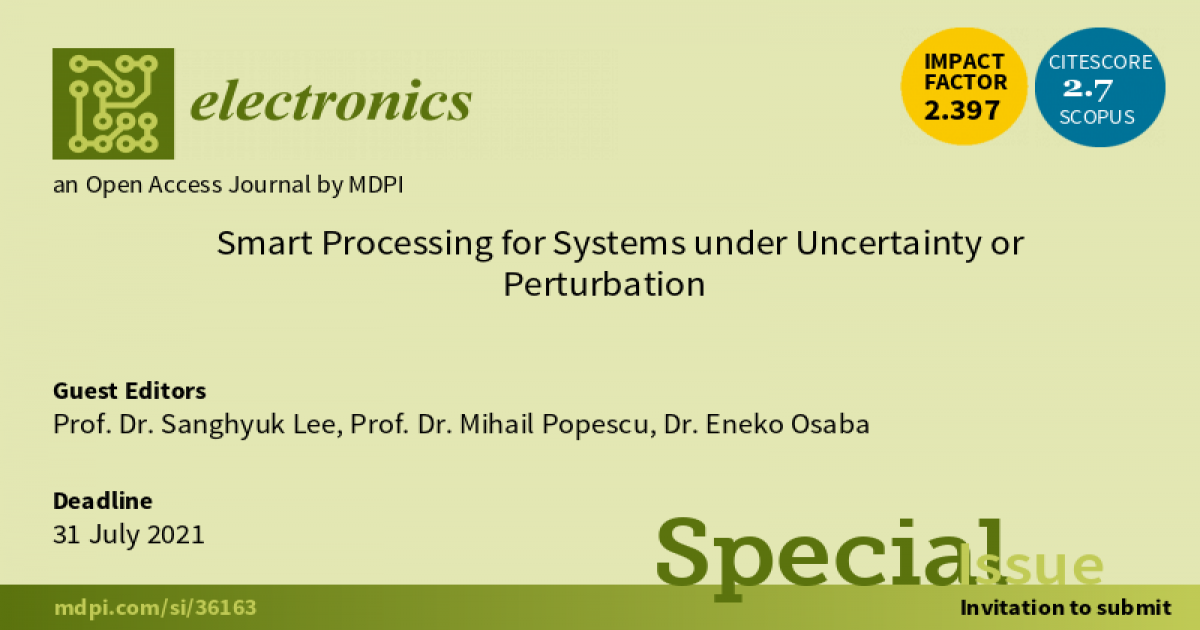Smart Processing for Systems under Uncertainty or Perturbation
A special issue of Electronics (ISSN 2079-9292). This special issue belongs to the section "Industrial Electronics".
Deadline for manuscript submissions: closed (31 July 2021) | Viewed by 50248

Special Issue Editors
Interests: control theory; data analysis; fuzzy set theory; robust controller design; energy optimization
Special Issues, Collections and Topics in MDPI journals
Interests: computational intelligence; fuzzy logic; image processing; sensor informatics; eldercare technology
Interests: bioinspired optimization; combinatorial optimization; artificial intelligence; metaheuristics; swarm intelligence
Special Issues, Collections and Topics in MDPI journals
Special Issue Information
Dear Colleagues,
With the development of artificial intelligence and learning algorithms, data processing and decision procedures have become possible for complex systems, large scale systems, and high-dimensional systems. Such achievements are supported by the development of high specification hardware. However, we are faced with output reliability issues due to variations in external inputs such as disturbances or uncertainty, because computation and processing relies on straight through processing. In this regard, we are focusing on research into robust performance with respect to external inputs from smart devices such as smart sensors or smart actuators. Hence, we are emphasizing aspects that give rise to effective and efficient solutions involving control algorithms for the implementation of smart devices. Generally, finding an optimal or suboptimal solution for a complex process with internal or external variation is challenging. As feasible methodologies, analytical approaches or metaheuristic algorithms are considered, and these include bio-inspired algorithms, artificial intelligence, and machine learning.
In this regard, we hope this Special Issue provides the opportunity to share our research ideas related to data networking and process optimization for smart systems. In this open forum, we are more than happy to receive your submissions and share research ideas relating to algorithms, optimization, and hardware implementations for complex system reliability.
Potential topics include, but are not limited to:
- Smart device applications in process control to improve performance;
- Smart device development and application to large-scale systems under disturbance;
- Intelligent algorithm design and application to industrial processes;
• Applications of deep learning to large-scale systems for efficiency; - Optimization algorithm development to large-scale system with uncertainty;
• Energy internet with efficient network communication;
• Data communication efficiency in large-scale systems;
• Nature-inspired algorithm application to smart grids; - Other related fields.
Prof. Dr. Sanghyuk Lee
Prof. Dr. Mihail Popescu
Dr. Eneko Osaba
Guest Editors
Manuscript Submission Information
Manuscripts should be submitted online at www.mdpi.com by registering and logging in to this website. Once you are registered, click here to go to the submission form. Manuscripts can be submitted until the deadline. All submissions that pass pre-check are peer-reviewed. Accepted papers will be published continuously in the journal (as soon as accepted) and will be listed together on the special issue website. Research articles, review articles as well as short communications are invited. For planned papers, a title and short abstract (about 100 words) can be sent to the Editorial Office for announcement on this website.
Submitted manuscripts should not have been published previously, nor be under consideration for publication elsewhere (except conference proceedings papers). All manuscripts are thoroughly refereed through a single-blind peer-review process. A guide for authors and other relevant information for submission of manuscripts is available on the Instructions for Authors page. Electronics is an international peer-reviewed open access semimonthly journal published by MDPI.
Please visit the Instructions for Authors page before submitting a manuscript. The Article Processing Charge (APC) for publication in this open access journal is 2400 CHF (Swiss Francs). Submitted papers should be well formatted and use good English. Authors may use MDPI's English editing service prior to publication or during author revisions.
Keywords
- large-scale system
- smart device
- optimization
- efficiency processing
- smart grid
- process control
- disturbance and uncertainty
- nature-inspired computation
Benefits of Publishing in a Special Issue
- Ease of navigation: Grouping papers by topic helps scholars navigate broad scope journals more efficiently.
- Greater discoverability: Special Issues support the reach and impact of scientific research. Articles in Special Issues are more discoverable and cited more frequently.
- Expansion of research network: Special Issues facilitate connections among authors, fostering scientific collaborations.
- External promotion: Articles in Special Issues are often promoted through the journal's social media, increasing their visibility.
- Reprint: MDPI Books provides the opportunity to republish successful Special Issues in book format, both online and in print.
Further information on MDPI's Special Issue policies can be found here.







